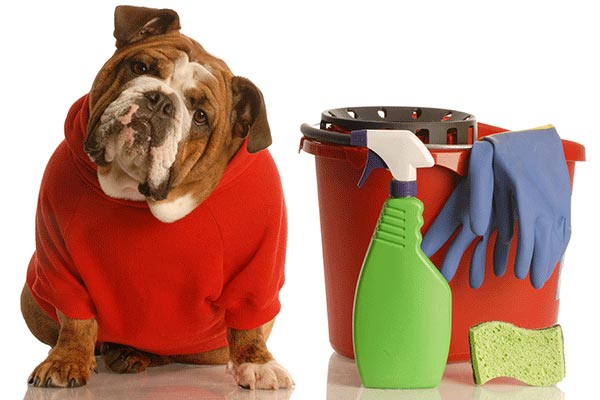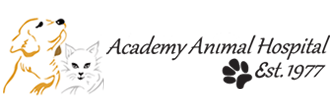Keeping Your Spring Cleaning Pet-Friendly

The grass is growing, trees are blooming, and rain is falling – must be spring! With the fresh start of a new, warmer season usually comes a deep “spring cleaning” of your house. It feels so good to have your home sparkling clean, but if you have pets, you’ll want to be sure your cleaning and redecorating choices won’t inadvertently harm your pets.
Today, we’ll share some insight on things to avoid – and things to include when spring cleaning a pet-friendly home:
Pet Safe Spring Cleaning? What Does That Mean?
Cleaning products are made with a whole host of harsh chemicals, many of which may be completely safe to humans, but harmful to our four legged friends. Pets can come into contact with some of these cleaners in ways humans wouldn’t (you don’t lick your feet… do you?) and ingesting chemicals like ammonia, chlorine, and alcohol can cause permanent damage.
Make sure you are cleaning with methods and products that won’t harm your pets, and don’t forget to include their bedding and toys in your deep clean (we’ll cover that later, too).
How Do I Clean My House in a “Pet Friendly” way?
Follow the Directions. The best advice in regards to cleaning – for both your safety and your pet’s – is to follow the cleaning product directions for both use and storage, the American Veterinary Medical Association suggests.
When a label instructs you to “keep away from pets and children” or “keep children and pets away until dry,” be sure to follow these directions. A curious kitty or pup that tracks their way through an area wet with bleach, ammonia, phenols, or other cleaning chemicals can suffer chemical burns to the paws, nose, and mouth, stomach upset, and respiratory irritation – particularly in cats.
Try Gentler, Pet- friendly Alternatives. While mixing up chemical concoctions in the kitchen can be just as dangerous as using a commercial cleaner, old standbys like baking soda and vinegar (not together, unless you are going for a science project-worthy volcano effect) can do the job.
Looking for something that smells less like salad dressing and readily available lie a “traditional” cleaner? Look for these pet-friendly, environmentally-friendly, and yet still highly effective brands – Mrs. Meyer’s Clean Day, Method, and Seventh Generation all offer a full range of cleaning products that work as fantastically as they smell, all while using plant-based, environmentally conscious, and pet friendly ingredients so you don’t have to worry about Fluffy being a little too nosey when you are spraying and scrubbing away.
Be careful with essential oils. While we do recommend natural choices for cleaners, be aware that essential oils can be harmful to pets. Remember, dogs in particular have a far more powerful sense of smell than humans - up to 100,000 times better. This powerful sniffer can become very overwhelmed when you use essential oils, making Penny irritable at best – and very sick at worst.
Some essential oils are harmful to animals. Whether diffused into the air or used as a part of a cleaning regimen, essential oils can cause similar problems to non-pet-safe cleaners, like vomiting, difficulty breathing, drooling, pawing at the face, weakness, and even tremors or seizures. Some of the more common oils to avoid for dogs and cats alike include: cinnamon, citrus, peppermint, pine, sweet birch, tea tree, clove, thyme, and eucalyptus. Consult the veterinarian for more information regarding the safety of essential oils and your pet.
How Can I Spring Clean Outside and stay “Pet-Friendly”?
Our yards are a common playplace (and let’s be honest, bathroom space) for our pets. Spring in Indiana means dandelions, thistles, fast growing grass that wants fed, and annual flowers. Chemical treatments for weed killing, grass growing, and flower boosting can be harmful if your curious little Barkley ingests them.
As with cleaners, follow the manufacturer’s directions and be sure to let these applications dry before letting pets out to play. If your pup likes to explore the yard, and sometimes eats things they shouldn’t, you should also be aware of what you plant in your yard. Some plants, like oleander, azalea, mums, hydrangea, English ivy, and rhubarb can cause problems ranging from a simple upset stomach to deadly seizures, coma, and kidney failure.
What Pet-Related Things Should I Clean This Spring?
If you are seriously looking to freshen up this spring, pet gear shouldn’t be left out. Pets benefit from a clean environment, too (and we all know that Bogart’s bed is probably contributing to that funky smell in the house).
Toys - Take some time to inspect their toys, anything that is super worn, stinky, broken, or unused should go. Clean the remaining toys with a pet-safe cleaner.
Crate or bed - If your pet sleeps in a crate, clean the crate pad and move the crate to do a thorough vacuuming underneath. Wash or replace any other pet bedding.
Bowls - According to the NSF, pet bowls are one of the germiest items in the home. Wash them regularly, just as you do your own dishes. If you haven’t been doing this, running them through the dishwasher is a safe choice.
Collar (& clothes) - Clean your pet’s collar with either pet shampoo or dishwashing liquid. Check care tags and wash any pet sweaters or jackets, using a scent free detergent and no fabric softener.
Spring cleaning can make your home feel fresh, and with these tips, clean and safe for you and your pets. Spring is also a good time to be sure your pet gets a “clean” bill of health. Call us at Academy Animal Hospital for your pet’s checkup and grooming needs today!
